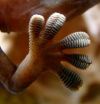(Press-News.org) COLUMBUS, Ohio – Scientists who sequenced the genome of the Antarctic midge suspect the genome's small size – the smallest in insects described to date – can probably be explained by the midge's adaptation to its extreme living environment.
The midge is a small, wingless fly that spends most of its two-year larval stage frozen in the Antarctic ice. Upon adulthood, the insects spend seven to 10 days mating and laying eggs, and then they die.
Its genome contains only 99 million base pairs of nucleotides, making it smaller than other tiny reported genomes for the body louse (105 million base pairs) and the winged parasite Strepsiptera (108 million base pairs), as well as the genomes of three other members of the midge family.
The midge genome lacks many of the segments of DNA and other repeat elements that don't make proteins, which are found in most animal genomes. The lack of such "baggage" in the genome could be an evolutionary answer to surviving the cold, dry conditions of Antarctica, said senior author David Denlinger, Distinguished Professor of entomology and of evolution, ecology and organismal biology at The Ohio State University.
"It has really taken the genome down to the bare bones and stripped it to a smaller size than was previously thought possible," Denlinger said. "It will be interesting to know if other extremophiles – ticks, mites and other organisms that live in Antarctica – also have really small genomes, or if this is unique to the midge. We don't know that yet."
Once called "junk DNA," these DNA segments and repeat elements in genomes are now known to have important functions related to gene regulation. They also are implicated in many disease processes. So could a bare-bones genome be the secret to midge survival?
"We don't yet understand what the implications are of not having all that extra baggage. It seems like a good thing in many ways, but organisms do get some beneficial things from this baggage, too," Denlinger said.
The midge genome is small in architecture but not in the number of genes, the researchers noted: The Antarctic midge genome, like genomes of other flies, contains about 13,500 functional genes.
The research is published in the journal Nature Communications.
Denlinger has studied the Antarctic midge for many years, zeroing in on the insect's unusual stress responses, including the activation of heat-shock proteins. Most animals turn on these proteins only when they're under acute stress – particularly when they're exposed to extremely high or low temperatures – and quickly turn them off when the stress has passed. But heat-shock proteins are activated constantly during the Antarctic midge's larval stage – a trait scientists believe is linked to its survival in harsh conditions.
Denlinger's lab has cloned and studied several genes connected to these proteins. "But sequencing the genome gives us access to a broader suite of many other closely related genes that we didn't have access to before," he said.
The research also reveals a host of genes called aquaporins, which are involved in water transport into and out of cells. These genes and the proteins they make are also players in the midge's survival in Antarctica. Most insects can survive losing about 20 percent of the water in their bodies' cells, but these midges tolerate a loss of up to 70 percent of their water.
"They look like dried up little raisins, and when we pour water on them they plump up and go on their merry way," Denlinger said. "Being able to survive that extreme level of dehydration is one of the keys to surviving low temperatures. This midge has some mechanism that enables it to both be dehydrated and stay alive, with its cells functioning normally."
In the Antarctic ecosystem, these midges eat bacteria and algae as well as nitrogen-rich waste produced by penguins. No other species preys on them, and Denlinger's lab has not identified any pathogens that might endanger their lives.
But they do have this incredible ability to survive a significant threat: the dry, deep freeze and high levels of ultraviolet radiation of Antarctica, and precisely how they do that remains, at least in part, a mystery. Though the survival question alone drives Denlinger's work, the research could have implications for humans in the long term by revealing how human tissue harvested for transplant could be sustained in cold storage.
"How does the midge regulate its physiology so it can survive in those kinds of low temperature extremes?" he said. "Having heat-shock proteins turned on all the time could offer some clues about how you might be able to preserve other tissues for a long time. Midges have figured out how to do that, so that means it is possible for some animal tissues to survive freezing temperatures."
INFORMATION:
This work was supported by grants from the National Science Foundation and the National Institutes of Health.
Co-authors include Joanna Kelley (now at Washington State University), Muh-Ching Yee (now at the Carnegie Institute for Science), Carlos Bustamante and Anna-Sophia Fiston-Lavier (now at the Université Montpellier in France) of Stanford University; Justin Peyton and Nicholas Teets of Ohio State's Department of Entomology; Spencer Johnston of Texas A&M University; and Richard Lee of Miami University.
Contact: David Denlinger
(614) 292-6425
Denlinger.1@osu.edu
Written by Emily Caldwell
(614) 292-8310
Caldwell.151@osu.edu
No excess baggage: Antarctic insect's genome, newly sequenced, is smallest to date
Researchers suggest bare-bones genome is adaptation to deep freeze
2014-08-12
ELSE PRESS RELEASES FROM THIS DATE:
Scientists discover the miracle of how geckos move, cling to ceilings
2014-08-12
CORVALLIS, Ore. – Researchers at Oregon State University have developed a model that explains how geckos, as well as spiders and some insects, can run up and down walls, cling to ceilings, and seemingly defy gravity with such effortless grace.
The solution, outlined today in the Journal of Applied Physics, is a remarkable mechanism in the toes of geckos that use tiny, branched hairs called "seta" that can instantly turn their stickiness on and off, and even "unstick" their feet without using any energy.
These extraordinary hairs contribute to the ability of geckos to ...
WSU researcher sees survival story in Antarctic fly's small genome
2014-08-12
PULLMAN, Wash.—Few animals can boast of being as tough as the Antarctic midge. Its larvae develop over not one but two Antarctic winters, losing nearly half their body mass each time. It endures high winds, salt, and intense ultraviolet radiation. As an adult, the midge gets by without wings and lives for only a week or so before starting its life cycle all over again.
And as Joanna Kelley has learned, it does this with the smallest insect genome sequenced so far.
"It's tiny," said Kelley, a Washington State University assistant professor, who recently sequenced and analyzed ...
Transgender relationships undermined by stigma
2014-08-12
PROVIDENCE, R.I. — Researchers who looked at the impact of discrimination, poverty and stigma on the mental health and relationship quality of transgender women and their male romantic partners found that social and economic marginalization not only takes a psychological toll on each person individually but also appears to undermine them as a couple.
It is difficult to be a transgender woman in the United States. Prior research has shown that they generally face high risks of depression, financial hardship, and discrimination, said study lead author Kristi Gamarel, a ...
Majority of Quebec children placed in out-of-home care are reunited with their family
2014-08-12
The majority of children in Quebec's youth protection system who are placed in out-of-home care (family foster care, or in a group or rehabilitation centre) are reunited with their "natural" families within 6 months, according to a study led by Professor Tonino Esposito of University of Montreal's School of Social Work. However, younger children, specifically those aged 2 to 5 years old at initial placement, have the lowest likelihood of returning to live with their natural families over time. "All placed children, irrespective of age, are less likely to return to live ...
Scared of crime? Good.
2014-08-12
EAST LANSING, Mich. -- In the past half-century, fear of crime in the United States has fueled "white flight" from big cities, become known as a quality of life issue and prompted scholars and law enforcement experts to address ways of reducing this fear.
But a study by a Michigan State University criminologist challenges this longstanding theory by arguing that a healthy fear of crime is, in fact, a good thing.
The study, published online in the journal Justice Quarterly, suggests adolescents who are more fearful of crime are less apt to become victims and offenders ...
ADHD, substance abuse and conduct disorder develop from the same neurocognitive deficits
2014-08-12
This news release is available in French. Researchers at the University of Montreal and CHU Sainte-Justine Research Centre have traced the origins of ADHD, substance abuse and conduct disorder, and found that they develop from the same neurocognitive deficits, which in turn explains why they often occur together. "Psychopathology exists on multiple continua of brain function. Some of these dimensions contribute to a multitude of problems, others contribute to specific problems. Together, they explain patterns of comorbidity such as why ADHD and conduct problems co-occur ...
Loss of eastern hemlock affects peak flows after extreme storm events
2014-08-12
The loss of eastern hemlock could affect water yield and storm flow from forest watersheds in the southern Appalachians, according to a new study by U.S. Forest Service scientists at the Coweeta Hydrologic Laboratory (Coweeta) located in Otto, North Carolina. The article was just published online in the journal Ecohydrology.
"Eastern hemlock trees have died throughout much of their range due to the hemlock woolly adelgid, an exotic invasive insect," said Steven Brantley, a post-doctoral researcher at Coweeta and lead author of the paper. "Though this insect has decimated ...
Graphene-based planar micro-supercapacitors for on-chip energy storage
2014-08-12
The rapid development of miniaturized portable electronic devices, such as micro-electromechanical systems, microrobots and implantable medical devices, has stimulated intense demand for micro-scale power sources. Although miniaturized micro-batteries that store energy by redox reactions provide the most frequently used micro-power source for current portable electronics on chip, their limited lifetime (hundreds or thousands of cycles) and low power density rule out applications that require high power over a short timeframe.
Micro-supercapacitors (MSCs) with a short ...
Researchers prove stability of wonder material silicene
2014-08-12
An international team of researchers has taken a significant step towards understanding the fundamental properties of the two-dimensional material silicene by showing that it can remain stable in the presence of oxygen.
In a study published today, 12 August, in IOP Publishing's journal 2D Materials, the researchers have shown that thick, multilayers of silicene can be isolated from its parent material silicon and remain intact when exposed to air for at least 24 hours.
It is the first time that such a feat has been achieved and will allow scientists to further probe ...
Prognosis of pneumonia: value of respiratory rate often overlooked
2014-08-12
Pneumonia – a severe lung infection – is the most common disease calling for hospital admission. More than one out of ten pneumonia patients die of the disease. Thus it is vital to accurately predict and closely monitor the clinical course. Here, measuring the respiratory rate – the number of breaths a person takes in a minute – provides valuable information. However, far too little use is still being made of this vital sign in clinical practice, as Richard Strauß and co-authors conclude in their recent study in Deutsches Ärzteblatt (Dtsch Arztebl Int 2014; 111: 503).
The ...
LAST 30 PRESS RELEASES:
Survey reveals ethical gaps slowing AI adoption in pediatric surgery
Stimulant ADHD medications work differently than thought
AI overestimates how smart people are, according to HSE economists
HSE researchers create genome-wide map of quadruplexes
Scientists boost cell "powerhouses" to burn more calories
Automatic label checking: The missing step in making reliable medical AI
Low daily alcohol intake linked to 50% heightened mouth cancer risk in India
American Meteorological Society announces Rick Spinrad as 2026 President-Elect
Biomass-based carbon capture spotlighted in newly released global climate webinar recording
Illuminating invisible nano pollutants: advanced bioimaging tracks the full journey of emerging nanoscale contaminants in living systems
How does age affect recovery from spinal cord injury?
Novel AI tool offers prognosis for patients with head and neck cancer
Fathers’ microplastic exposure tied to their children’s metabolic problems
Research validates laboratory model for studying high-grade serous ovarian cancer
SIR 2026 delivers transformative breakthroughs in minimally invasive medicine to improve patient care
Stem Cell Reports most downloaded papers of 2025 highlight the breadth and impact of stem cell research
Oxford-led study estimates NHS spends around 3% of its primary and secondary care budget on the health impacts of heat and cold in England
A researcher’s long quest leads to a smart composite breakthrough
Urban wild bees act as “microbial sensors” of city health.
New study finds where you live affects recovery after a hip fracture
Forecasting the impact of fully automated vehicle adoption on US road traffic injuries
Alcohol-related hospitalizations from 2016 to 2022
Semaglutide and hospitalizations in patients with obesity and established cardiovascular disease
Researchers ‘listen in’ to embryo-mother interactions during implantation using a culture system replicating the womb lining
How changing your diet could help save the world
How to make AI truly scalable and reliable for real-time traffic assignment?
Beyond fragmented markets: A new framework for efficient and stable ride-pooling
Can shape priors make road perception more reliable for autonomous driving?
AI tracks nearly 100 years of aging research, revealing key trends and gaps
Innovative techniques enable Italy’s first imaging of individual trapped atoms
[Press-News.org] No excess baggage: Antarctic insect's genome, newly sequenced, is smallest to dateResearchers suggest bare-bones genome is adaptation to deep freeze




